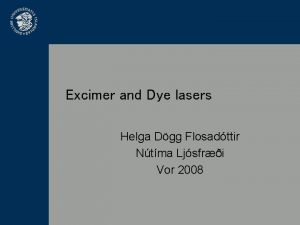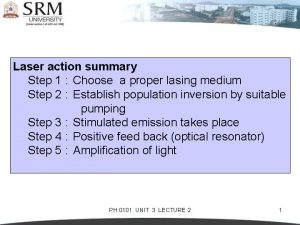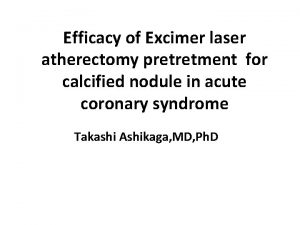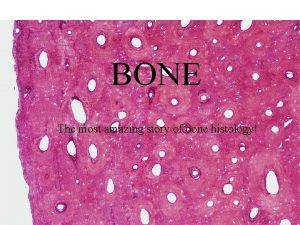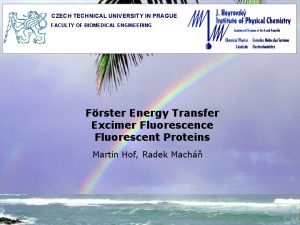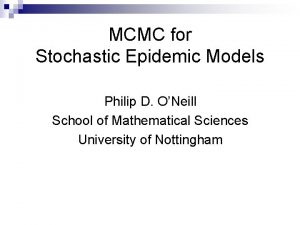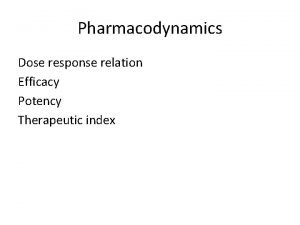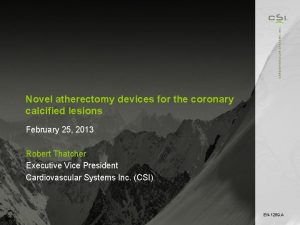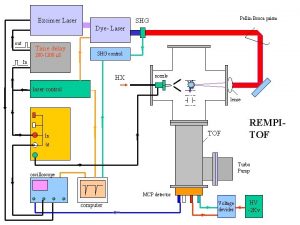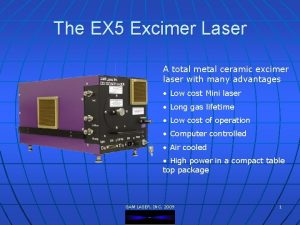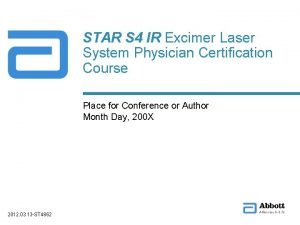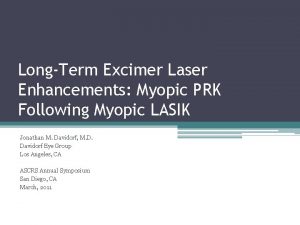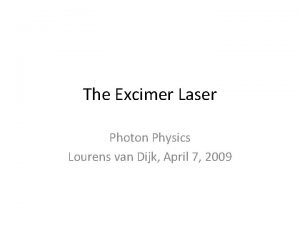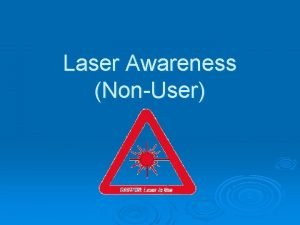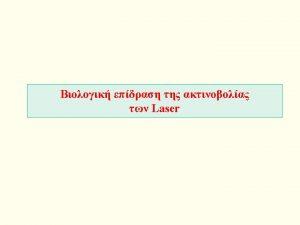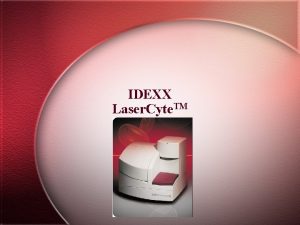Efficacy of Excimer laser atherectomy pretretment for calcified











- Slides: 11

Efficacy of Excimer laser atherectomy pretretment for calcified nodule in acute coronary syndrome Takashi Ashikaga, MD, Ph. D

Background • The frequency of thrombi in sudden death is 60% in histopathological findings. The following underlying causes were shown to be plaque rupture in 55 -60%, plaque erosion in 30 -35% and calcified nodule in 2 -7%. • Although the clinical outcome with calcified nodule in nonculprit lesion is well, that in culprit lesion is not well understood. Asymmetrical and underdilated stent expansion for calcified nodule were demonstrated in clinical practice. • Excimer laser angioplasty

CASE PRESENTATION WITHOUT EXCIMER LASER ANGIOPLASTY FOR CALCIFIED NODULE CONTROL Final(3. 5/32 mm PES) OCT POBA Final 72 -year old male admitted to our hospital due to ACS. Culprit lesion was RCA with calcium nodule. After POBA, 3. 5/32 mm PES deployment was performed. Although angiogram showed adequate dilatation, OCT showed asymmetrical and underdilated stent expansion after using 3. 75 mm balloon postdilatation.

Objective • Excimer laser atherectomy is known to be effective for vaporizing thrombus containing lesions in acute coronary syndrome. • However, it is less known about the efficacy of excimer laser atherectomy for calcified nodule in acute coronary syndrome.

CASE PRESENTATION Case: 69 year old Female Risk Factors: Hypertension, DM (hemodialysis) History: She complained chest pain at rest and the 12 -lead ECG revealed ST depression in inferior leads. Emergent coronary angiogram revealed severe stenosis in the proximal RCA (Fig. 1). IVUS findings showed a nodular and hyperechoic apperance with luminal protrusion (Fig. 2). Imap IVUS also showed some calcified lesion in the protruded site (Fig. 3). (Fig. 1) (Fig. 2) (Fig. 3)

IVUS & OCT findings A A C B E D To confirm this lesion more clearly, OCT was performed. In the nodular lesion, the signal composition at the luminal surface displays first a very thin bright layer followed a very thin signal-poor layer, followed by a homogenous tissue composition with high light attenuation. From IVUS and OCT findings, this lesion was diagnosed as a calcified nodule with thrombus containing lesion. Top: IVUS finding before ELCA Middle: OCT findings before ELCA F B C D E F

Angiographic view during ELCA • Angiogram before ELCA was shown in Fig. 4. • Excimer laser concentric catheter (1. 4 mm) was applied for this calcified nodule (Fig. 5). We started with laser energy at 45 fluence and 25 Hz. Laser energy was increased to 50 fluence and 30 Hz for two additional sequences. • Angiogram after ELCA was shown in Fig. 6. (Fig. 4) (Fig. 5) (Fig. 6)

OCT findings after ELCA A B A C B E D F C D A: B: C: D: E F distal site detached plaque with ELCA was seen dissection with ELCA was seen lumen enlargement was accomplished with ELCA E: vaporization of calcified nodule and thrombus containing lesion with ELCA F: proximal site

Angiogram & OCT finding in final result • Then 3. 0/18 mm BMS was delivered in the lesion location. • After postdilatation with a 4. 0/12 mm high pressure balloon, final angiogram was acceptable (Fig. 6). • OCT findings also demonstrated the adequate stent expansion (Fig. 7) (Fig. 6) (Fig. 7)

Comment • It is less known about the efficacy of PCI with calcified nodule. However, asymmetrical and underdilated stent expansion was shown in clinical practice. • Excimer laser coronary atherectomy was performed in patient with calcified nodule. In IVUS and OCT findings, not only the reduction of plaque including calcified nodule but also the lumen enlargement could be accomplished with ELCA. • We demonstrated here that the symmetrical and adequate stent expansion could be accomplished with pretreatment of excimer laser atherectomy for this calcified nodule.

Conclusion • Some cases with acute coronary syndrome were shown to be due to calcifed nodule in the histopathological findings. • Pretreatment with excimer laser atherectomy was effective for symmetrical and adequate stent expansion in cases with calcified nodule. • Pretreatment of excimer laser atherectomy may be effective for the reduction of stent restenosis and/or stent thrombosis for calcified nodule.
